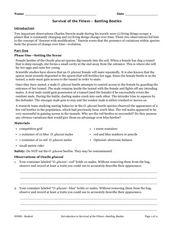Curated Video
Charles Darwin's Observations | Evolution | Biology | FuseSchool
Charles Darwin was a keen naturalist and geologist who made detailed observations about the natural world. Whilst studying at Cambridge, Darwin learnt many important scientific skills including species identification, how to catalogue...
Curated Video
The Theory of Evolution by Natural Selection
"The Theory of Evolution by Natural Selection Where did humans, and all the other living things on our planet come from? This problem puzzled humans for centuries, and there have been many different theories through the ages. Then, in...
SciShow
Goodall, Fossey & Galdikas: Great Minds
Today we know that humans and chimpanzees share 99% of their DNA and that we have a lot in common. Not just how we look, but how we behave, form groups, defend our turf, and love each other. People didn't always see other primates this...
Curated Video
Evolution by Natural Selection - Darwin's Finches | Evolution | Biology | FuseSchool
Evolution by Natural Selection - Darwin's Finches | Evolution | Biology | FuseSchool The study of finches led to the development of one of the most important scientific theories of all time. In December 1831 a naturalist called Charles...
Curated Video
BIOLOGY - Evolution -Competition & Natural Selection
In nature, all organisms compete with each other for resources in order to survive. Competition between members of the same species is what makes organisms evolve. This theory of competition and ‘survival of the fittest’ is called...
TED-Ed
TED-ED: Why the insect brain is so incredible - Anna St_ckl
The human brain is one of the most sophisticated organs in the world, a supercomputer made of billions of neurons that control all of our senses, thoughts, and actions. But there was something Charles Darwin found even more impressive:...
TED Talks
TED: I believe we evolved from aquatic apes | Elaine Morgan
(NOTE: Statements in this talk have been challenged by scientists working in this field. Read "Criticisms & updates" below for more details.) Elaine Morgan was a tenacious proponent of a theory that is not widely accepted. The aquatic...
Curated Video
Evidence for Natural Selection | Evolution | Biology | FuseSchool
Fossils discovered within rocks led scientists to begin to change their ideas on the creation of life on earth. Charles Darwin's 5 year voyage on HMS Beagle led to him collecting different flora and fauna from the countries he visited....
Curated Video
The Theory of Evolution by Natural Selection | Evolution | Biology | FuseSchool
The Theory of Evolution by Natural Selection Where did humans, and all the other living things on our planet come from? This problem puzzled humans for centuries, and there have been many different theories through the ages. Then, in the...
Curated Video
Competition and Natural Selection | Evolution | Biology | FuseSchool
In nature, all organisms compete with each other for resources in order to survive. Competition between members of the same species is what makes organisms evolve. This theory of competition and ‘survival of the fittest’ is called...
Curated Video
Springs
"Springs | Forces & Motion | Physics | FuseSchool In this video you will learn about compression, extension, elastic limit and elastic potential energy. CREDITS Animation & Design: Joshua Thomas Narration: Dale Bennett Script: Bethan...
SciShow
Where Do Our Facial Expressions Come From?
Our facial expressions convey a lot about our emotions, but why? Hank explores how our evolution has helped form how we communicate with our faces. Hosted by: Hank Green ---------- Support SciShow by becoming a patron on Patreon:...
Safe Routes to School
Pollution & Evolution
Bring together a study of two major scientific topics with a lesson on the relationship between pollution and evolution. With the help of a PowerPoint presentation, hands-on activity. and class demonstration young scientists learn how...
Curated OER
Survival of the Fittest -- Battling Beetles
Students experiment with traits. In this Science lesson, students test the strength of beetles using M&M candies in lieu of the insects. Students use the Hardy-Weinberg Equation to calculate possible offspring traits of further...










